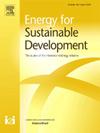Confronting uncertainty: The future of hydropower in the himalayan region amidst climate ambiguity
IF 4.4
2区 工程技术
Q2 ENERGY & FUELS
引用次数: 0
Abstract
Uncertainty profoundly influences hydropower projections under climate change, involving both aleatory and epistemic factors and necessitating varied methodological approaches. This study integrates top-down (General Circulation Models (GCM)) and bottom-up machine learning-based projections, incorporating land use changes using the Soil and Water Assessment Tool. GCMs predict substantial precipitation increases, up to 52.39 % under SSP5–8.5 scenarios, with temperature changes ranging from 0.77 °C to 6.21 °C. In contrast, bottom-up approaches forecast declining basin-wide precipitation from September to December, followed by increases. Spring-fed and snow-fed rivers generally show higher flows in GCM scenarios but lower flows in bottom-up scenarios. Snow-fed rivers exhibit notably greater discharge and energy variability compared to spring-fed rivers, with secondary energy experiencing more significant fluctuations than primary energy. This study underscores the need for diverse methodologies in hydropower planning and highlights the importance of integrating modeling approaches and enhancing collaboration among hydrologists, climate scientists, and policymakers. Future research should focus on combining multiple methodologies for more comprehensive climate impact assessments.
面对不确定性:在气候模糊的喜马拉雅地区水电的未来
不确定性深刻地影响着气候变化下的水电预测,它涉及偶然性和认知性因素,需要不同的方法方法。这项研究结合了自上而下(一般循环模型(GCM))和自下而上的基于机器学习的预测,利用水土评估工具将土地利用变化纳入其中。GCMs预测,在SSP5-8.5情景下,气温变化范围在0.77°C至6.21°C之间,降水将大幅增加,增幅达52.39%。相反,自下而上方法预测9 - 12月全流域降水先减少后增加。在GCM情景下,泉源和雪源河流的流量普遍较高,而自下而上情景下流量较低。与泉源河流相比,雪源河流的流量和能量变异性明显更大,其中二次能量的波动比一次能量更显著。这项研究强调了在水电规划中需要多样化的方法,强调了整合建模方法和加强水文学家、气候科学家和决策者之间合作的重要性。未来的研究应侧重于结合多种方法进行更全面的气候影响评估。
本文章由计算机程序翻译,如有差异,请以英文原文为准。
求助全文
约1分钟内获得全文
求助全文
来源期刊

Energy for Sustainable Development
ENERGY & FUELS-ENERGY & FUELS
CiteScore
8.10
自引率
9.10%
发文量
187
审稿时长
6-12 weeks
期刊介绍:
Published on behalf of the International Energy Initiative, Energy for Sustainable Development is the journal for decision makers, managers, consultants, policy makers, planners and researchers in both government and non-government organizations. It publishes original research and reviews about energy in developing countries, sustainable development, energy resources, technologies, policies and interactions.
 求助内容:
求助内容: 应助结果提醒方式:
应助结果提醒方式:


